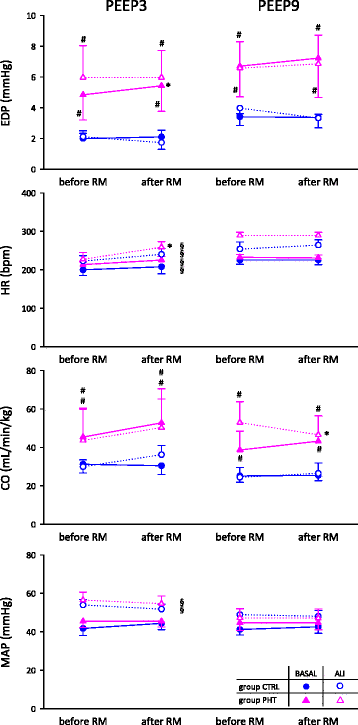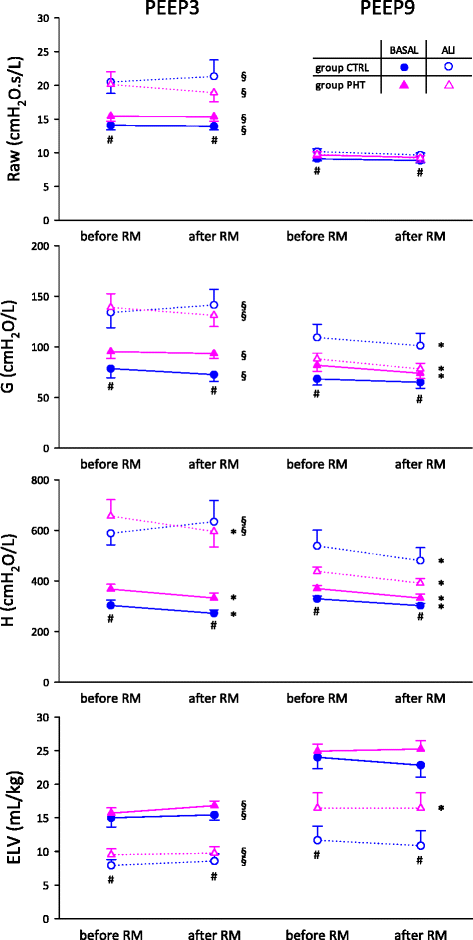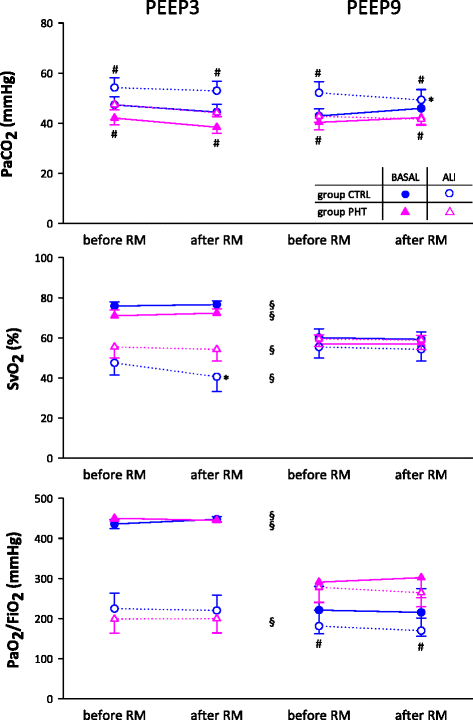Cardiorespiratory effects of recruitment maneuvers and positive end expiratory pressure in an experimental context of acute lung injury and pulmonary hypertension
- PMID: 26228052
- PMCID: PMC4521467
- DOI: 10.1186/s12890-015-0079-y
Cardiorespiratory effects of recruitment maneuvers and positive end expiratory pressure in an experimental context of acute lung injury and pulmonary hypertension
Abstract
Background: Recruitment maneuvers (RM) and positive end expiratory pressure (PEEP) are the cornerstone of the open lung strategy during ventilation, particularly during acute lung injury (ALI). However, these interventions may impact the pulmonary circulation and induce hemodynamic and respiratory effects, which in turn may be critical in case of pulmonary hypertension (PHT). We aimed to establish how ALI and PHT influence the cardiorespiratory effects of RM and PEEP.
Methods: Rabbits control or with monocrotaline-induced PHT were used. Forced oscillatory airway and tissue mechanics, effective lung volume (ELV), systemic and right ventricular hemodynamics and blood gas were assessed before and after RM, during baseline and following surfactant depletion by whole lung lavage.
Results: RM was more efficient in improving respiratory elastance and ELV in the surfactant-depleted lungs when PHT was concomitantly present. Moreover, the adverse changes in respiratory mechanics and ELV following ALI were lessened in the animals suffering from PHT.
Conclusions: During ventilation with open lung strategy, the role of PHT in conferring protection from the adverse respiratory consequences of ALI was evidenced. This finding advocates the safety of RM and PEEP in improving elastance and advancing lung reopening in the simultaneous presence of PHT and ALI.
Figures





Similar articles
-
Comparison of static end-expiratory and effective lung volumes for gas exchange in healthy and surfactant-depleted lungs.Anesthesiology. 2013 Jul;119(1):101-10. doi: 10.1097/ALN.0b013e3182923c40. Anesthesiology. 2013. PMID: 23571638
-
Recruitment maneuvers in three experimental models of acute lung injury. Effect on lung volume and gas exchange.Am J Respir Crit Care Med. 2000 May;161(5):1485-94. doi: 10.1164/ajrccm.161.5.9809014. Am J Respir Crit Care Med. 2000. PMID: 10806143
-
Cardiopulmonary effects of matching positive end-expiratory pressure to abdominal pressure in concomitant abdominal hypertension and acute lung injury.J Trauma. 2010 Aug;69(2):375-83. doi: 10.1097/TA.0b013e3181e12b3a. J Trauma. 2010. PMID: 20699747
-
[Mechanical ventilation and fluid management in acute lung injury. Effects on gas exchange and hemodynamics].Anaesthesist. 2009 Apr;58(4):410-4. doi: 10.1007/s00101-009-1525-0. Anaesthesist. 2009. PMID: 19326053 Review. German.
-
Pros and cons of recruitment maneuvers in acute lung injury and acute respiratory distress syndrome.Expert Rev Respir Med. 2010 Aug;4(4):479-89. doi: 10.1586/ers.10.43. Expert Rev Respir Med. 2010. PMID: 20658909 Review.
Cited by
-
Variable Ventilation Is Equally Effective as Conventional Pressure Control Ventilation for Optimizing Lung Function in a Rabbit Model of ARDS.Front Physiol. 2019 Jun 26;10:803. doi: 10.3389/fphys.2019.00803. eCollection 2019. Front Physiol. 2019. PMID: 31297064 Free PMC article.
References
-
- Dyhr T, Laursen N, Larsson A. Effects of lung recruitment maneuver and positive end-expiratory pressure on lung volume, respiratory mechanics and alveolar gas mixing in patients ventilated after cardiac surgery. Acta Anaesthesiol Scand. 2002;46(6):717–25. doi: 10.1034/j.1399-6576.2002.460615.x. - DOI - PubMed
MeSH terms
LinkOut - more resources
Full Text Sources
Other Literature Sources
Medical

